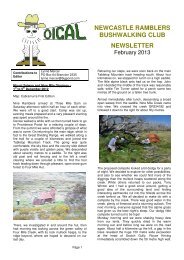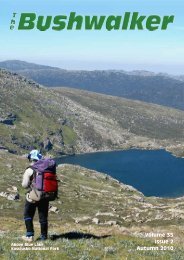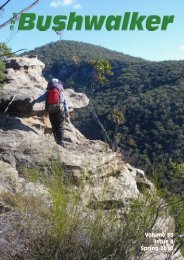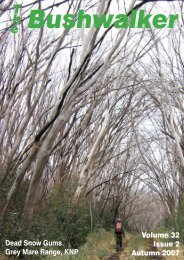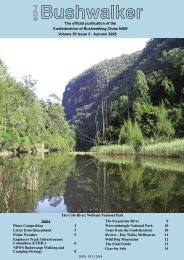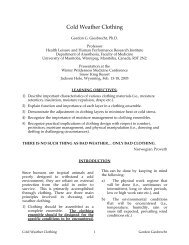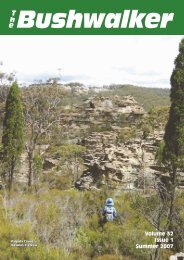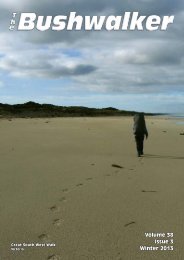Walk Safely—Walk with a ClubTread on a path in the Pyrenees and youstep into rich and varied history. Precedingthe walks <strong>of</strong> our Bush Club (Group 3)in June 2006 were not only other groups<strong>of</strong> Australian walkers but also some <strong>of</strong> themost bloody invasions and expeditionaryforces <strong>of</strong> recorded history and religion. Theline up includes Roman, French, Spanishand Moorish Empires, and Catholic, Protestantand Islamic waxings and wanings.The indelible mark <strong>of</strong> mankind is ubiquitousin the Pyrenees.Pilgrims <strong>of</strong> the Chemin de St Jacques deCompostelle, readily identifiable by atleast one scallop shell (Pecten maximus)on their packs or clothing, come to retracethe reputed steps <strong>of</strong> John the Baptist fromvarious commencing points in Francethrough the Pyrenees all the way to thetown <strong>of</strong> Saint John de Compostela on theAtlantic Spanish coast.Real bush? Old growth forest? Naturalenvironment? In some places there aresome remnants <strong>of</strong> what might have beenafter the last ice age. Much <strong>of</strong> the naturalenvironment - serried peaks <strong>of</strong> geologicallyyoung fold mountains and once vastoak and beech forests, has been replacedwith pastures on even the most precipitousslopes. Here goats, sheep, wild horses andcattle share the walking trails with pilgrimsand mountaineers. Above the sky is full <strong>of</strong>flocks <strong>of</strong> griffon vultures and other raptorsmajestically riding the thermals in a constantsearch for the next meal. The occasionaldeer can be surprised in the woodsand rabbits abound.The 2006 European summer season hada torrid start, with the mercury in the midthirties every day. With humidity to matchit was very like midsummer in Sydney.Our base in the rural Payes Basque was anold 18th century farmhouse, named Etxexuria(pronounced Etcherchuria or just“Etchers”). This is located in the LantabatValley near the tiny hamlet <strong>of</strong> St Martin andis about 40 minutes from St Jean Pied dePort. The house has been completely renovatedand is a very comfortable abode. | The BushwalkerGroup organizersand hosts Bob andSue Taffel were atstation and airportto welcome usand provide transportto Etchers.We were a mixedlot – comprisingnon-walkers,moderate walkersand addictedwalkers. It wasBob’s task to runa program that made everybody happy. Hedid a remarkable job.Part <strong>of</strong> the charm <strong>of</strong> the visit was to indulgein the local cuisine. Our cook Sallywas, surprisingly, English but through hercraft as a ‘cuisenaire’ had developed all theskills necessary to ‘cook like a local’. Hermeals used local recipes made with freshingredients bought in the local markets,served with local wines.To the walking. Bob chose fairly localwalks to suit the varying abilities and hightemperatures. Pack walking would havebeen great but was not an option.Our first walk started at Col d’Iphariatze,a saddle at 328 m and a none-too-inspiringplace, bare <strong>of</strong> trees and windswept.Our route was along a ridge, followed bya steep descent into the Pagardeyko Erreka(Erreka = Creek). Humidity was high andwe were grateful for the shade <strong>of</strong> the oaktrees. To the east was the Bois d’Ostabat(Ostabat Forest); this green patch wasmost welcome. To our west was a prettycollection <strong>of</strong> more than a dozen villagesincluding Behaune, Ascombeguey and Orsanco.Most sported a church steeple andprovided serial photograph opportunities.As we swung east onto the GR 65 we encounteredpilgrims. By the time we reachedthe Chapelle de Soyarza there were frequentgroups <strong>of</strong> pilgrims in both directions. Thechapel is surrounded by a planting <strong>of</strong> planetrees, pollarded and cajoled into forming acontinuous, interwoven crown. The effectis dramatic given that the chapel is so elevated.Here we enjoyed morning tea andlimited conversation with pilgrims.Then it was time to head southwest to Harambeltzand the chapel <strong>of</strong> St Nicholas. Thischapel is in a rather sad state, now beingmostly used for storing agricultural items.This was where we had lunch. Some ateoutside but the heat drove three <strong>of</strong> us intothe undercr<strong>of</strong>t area where large squaredbeams now lying on the floor improvisedas seats. Whether it was the location, theheat, the bizarre carved symbols in thestonework or just the right moment but Irecall the conversation being very philosophical,deep and meaningful.As we passed through the south-west section<strong>of</strong> the Bois d’Ostabat, near HarambeltzkoErreka, there were improvisedladders fixed to very large trees that ledto hides, for pigeon shooters. The climbingwas good fun and provided excitementand photo opportunitiesAfter crossing another Erreka – the Ithurriberriako,we joined the Chemin de St.Jacques de Compostelle where time andfeet have lowered the track level by nearlya metre, resulting in a tunnel like effect.Emerging from the tunnel we were soonin the village <strong>of</strong> Ostabat. Here were some17th century buildings still in use includingone that served the function <strong>of</strong> a gited’etape or hostel for travellers: devout pilgrimsor a seasoned bushwalkers.Given the heat we decided that althoughit was Sunday we all merited a drink. Thelocal hostelry was open so in we went.Whilst a beer was popular the most consumeddrink by far was a “Citron Presse”.Made from freshly squeezed lemons, thisdrink is served with an accompanyingjug <strong>of</strong> chilled water and for the weak, abowl <strong>of</strong> sugar. It is truly refreshing and nohangovers. Mind you, one <strong>of</strong> these withoutsugar is about all a guy can handle.Our second walk was to the south west <strong>of</strong>Etchers. We drove through the villages <strong>of</strong>Iholdy, Irissary, Osses and Saint EtiennedeBaigorry and up the steep foothillslopes <strong>of</strong> Aintziaga (872 m) to park at theborder crossing <strong>of</strong> Col d’Ispeguy (672 m).What followed was a truly beautiful walkthrough oak and beech forest along theslopes <strong>of</strong> Olate (935 m)We border crossed several times as wepassed through Nekaitzeko and the Col<strong>Vol</strong><strong>31</strong> Issue 3, Winter 2006
d’Elhorrieta. Shepherds <strong>of</strong> long ago hadconstructed stone corrals to protect theflocks at night. Today the crumbling stonewalls and terra cotta tiled ro<strong>of</strong>s make itimpossible not to achieve postcard perfectshots <strong>of</strong> this area. The long-haired sheepwith their black faces and habit <strong>of</strong> nuzzlingeach other make for unforgettable imagesin beautiful scenery.At the saddle was a rare find in the modernworld – the border between two majorcountries completely open and markedonly by border stones (‘bornes’) every fewhundred metres. In real tourist fashion weposed with our legs straddling the border.Five <strong>of</strong> us set out from the saddle to climbAutza (1,304 m). An irrestistable part <strong>of</strong>the deal was to summit and return in 90minutes! As we climbed the views becamespectacular but the wind became an issue,with some gusts lifting you <strong>of</strong>f the ground.One member reluctantly turned back.Above the tree line there was no real pad tothe top, and across the rock scree there wasno identifiable route at all. Two <strong>of</strong> us reallyforced our pace and finally, using everybit <strong>of</strong> shelter, managed to reach the ‘first’summit, an area <strong>of</strong> ground that looked likepeat which was eroding rapidly. From thispoint we were able to walk and climb withrelative ease as the top <strong>of</strong> the mountain protectedus from the worst <strong>of</strong> the wind.These mountains are relatively young foldmountains and include an array <strong>of</strong> sedimentaryformations that have been squeezedand buckled to form the high peaks. Thediversity <strong>of</strong> rock types was amazing: sandstones,quartzites, greywackes, volcanicbreccias, mudstones and conglomerates.Each <strong>of</strong> these rock types revealed something<strong>of</strong> the changing environments whenthey were laid down.Finally the top was ours. We had allowed60 minutes up and 30 down: we had 5 minutesspare. This we used to look around,Walk Safely—Walk with a Clubas the ‘top’ is quite extensive. Imagine oursurprise when we found a small depressionat the top complete with a contingent<strong>of</strong> 8 armoured soldiers in full battledress,hunkered down speaking on walkie talkiesto others in their unit. Their language wasprobably Basque as neither <strong>of</strong> us could detectFrench or Spanish. <strong>No</strong>w was the timefor photos. Opportunities to have your picturetaken with such a backdrop are rarewithout faking it.On the way down we consoled our two teammates who ran out <strong>of</strong> time to join us on thesummit. Back with the group they allowedus time to snatch a bit <strong>of</strong> lunch and retailour story. The return journey was nearly allin Spain and was a pleasant stroll back tothe general store (‘venta’) where we hadparked the cars. Bob invited us in to explorethe diverse (!) range <strong>of</strong> goods on sale:marijuana, cooking pots, guns, clothes,food <strong>of</strong> every description, cow bells, bootsand knick-knacks. Jewellery was availablenext to miner’s picks and farm utensils.Great pitch-forks with wooden tines stoodoutside. It was bizarre and reportedly typical<strong>of</strong> many border establishments.We asked for “Citron Presse” but alas theyhad no citrons. We had to settle for a bottledversion which, while itdid not pack quite the samepunch, was an acceptable thirstquencher.That night Sally put on a typicalBasque meal. There weresausages and meats from thearea, two varieties <strong>of</strong> rich localpate, local potatoes, an amazingselection <strong>of</strong> char grilledcapsicums, chillies, mushroomsand zucchinis, and aselection <strong>of</strong> local cheeses andbreads. Adding the beer andwines that Bob had laid inmade a feast fit for a king.The highest peak on the walkon day three was Larla (700m). The start was considerablylower at the village <strong>of</strong> StMartin d’Arrossa – about 250m. Stunning flowering pinktamarisk scented the air. As weclimbed the La Nive River wasrevealed, sparkling in the sun.Near the top <strong>of</strong> first ridge wedisturbed a DIY builder creatinga home in a great setting asremote as it is possible to be inthe Pyrenees. With words <strong>of</strong>encouragement we left him tohis labours and pushed on.Morning tea was taken highup on a side road near a decayingcollection <strong>of</strong> farm buildings. Some realeffort had been expended in constructingthe track along the ridge line: at times theretaining wall was over 2 m in height andthe road capable <strong>of</strong> a small vehicle. Neglectand erosion made it now useless except as afootpad. Also along this section is a collection<strong>of</strong> crumbling shepherd’s huts that providemore excuses to take photographs <strong>of</strong>this stunning scenery. On several huts thero<strong>of</strong>s as well as the walls are made fromlichen-encrusted flag stones that look sogood.From Larla there are dramatic views to thewest <strong>of</strong> the ridge that marks the border betweenFrance and Spain. Called the Creted’Iparla, its highest point is Pic d’Iparla,some 1044 m high. It just begs to be climbed.Shortly after admiring this ridge we had a<strong>Vol</strong><strong>31</strong> Issue 3 Winter 2006The Bushwalker |



